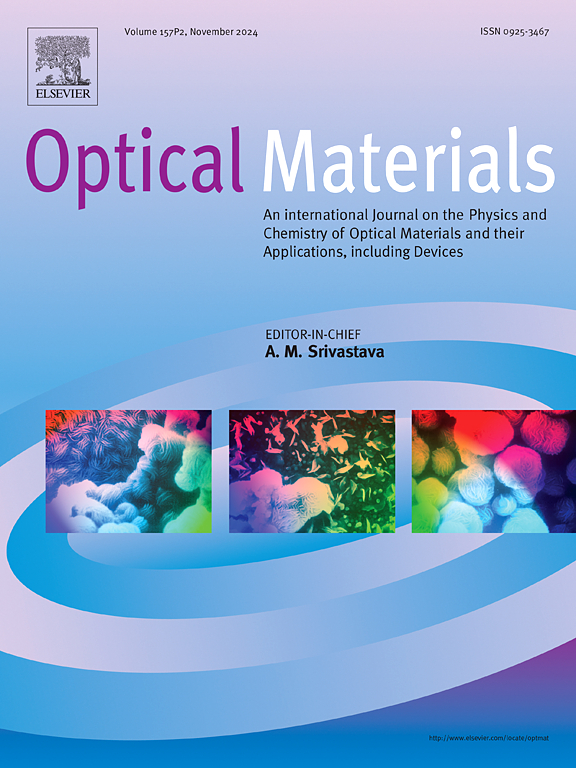Graphitic-C3N4 modified by 9-phenylcarbazole groups and used as a metal-free phosphor in white light-emitting diodes
IF 3.8
3区 材料科学
Q2 MATERIALS SCIENCE, MULTIDISCIPLINARY
引用次数: 0
Abstract
Graphitic-C3N4 (g-C3N4) and some of its derivatives can be used as cheap and renewable rare-earth-free phosphors for replacing widely-used rare-earth-based phosphors in LEDs. Here, a 9-phenylcarbazole modified g-C3N4 derivative (g–C3N4–PhCz) was synthesized via thermal polymerization by using melamine as the main precursor and 6-(4-(9H-carbazol-9-yl)phenyl)-1,3,5-triazine-2,4-diamine as the molecular dopant at the molar ratio of 30:1, 450 °C, for 2 h. Such g–C3N4–PhCz emits bright greenish-yellow light with a high quantum yield of 30.1 %, which is much higher than that of bulk g-C3N4 (around 5.0 %). Moreover, it shows high thermal stability (thermal decomposition temperature is up to 465 °C) and low thermal quenching property (photoluminescence intensity retains 91.5 % at 110 °C relative to that at 30 °C). Under the excitation of GaN-based blue light chips, a series of high-quality cold/neutral/warm white LEDs were successfully fabricated by using g–C3N4–PhCz together with red-emitting K2SiF6:Mn4+ (also rare-earth-free) as phosphors. For example, the Commission Internationale de l'Éclairage (CIE) chromaticity coordinates can reach (0.3320, 0.3330) which is very close to (0.3333, 0.3333) of pure white light. Relative to the luminescent property of g-C3N4, that of g–C3N4–PhCz has been significantly improved and it is more suitable for white LEDs.

经9-苯基咔唑基团修饰的石墨- c3n4用作白光发光二极管的无金属荧光粉
石墨- c3n4 (g-C3N4)及其衍生物可作为廉价、可再生的无稀土荧光粉替代led中广泛使用的稀土荧光粉。本文以三聚氰胺为主要前驱体,以6-(4-(9h -咔唑-9-基)苯基)-1,3,5-三嗪-2,4-二胺为分子掺杂剂,在450℃下,以30:1的摩尔比反应2 h,通过热聚合合成了9-苯基咔唑修饰的g-C3N4衍生物(g-C3N4 - phcz)。该g-C3N4 - phcz发出明亮的绿黄色光,量子产率高达30.1%,远高于本体g-C3N4(约5.0%)。此外,它具有较高的热稳定性(热分解温度高达465℃)和较低的热猝灭性能(在110℃时的光致发光强度相对于30℃时保持91.5%)。在gan基蓝光芯片的激发下,以g-C3N4-PhCz和红发K2SiF6:Mn4+(同样不含稀土)为荧光粉,成功制备了一系列高品质的冷/中性/暖白光led。例如,国际委员会Éclairage (CIE)色度坐标可以达到(0.3320,0.3330),非常接近纯白光的(0.3333,0.3333)。相对于g-C3N4的发光性能,g-C3N4 - phcz的发光性能有了明显的提高,更适合于白光led。
本文章由计算机程序翻译,如有差异,请以英文原文为准。
求助全文
约1分钟内获得全文
求助全文
来源期刊

Optical Materials
工程技术-材料科学:综合
CiteScore
6.60
自引率
12.80%
发文量
1265
审稿时长
38 days
期刊介绍:
Optical Materials has an open access mirror journal Optical Materials: X, sharing the same aims and scope, editorial team, submission system and rigorous peer review.
The purpose of Optical Materials is to provide a means of communication and technology transfer between researchers who are interested in materials for potential device applications. The journal publishes original papers and review articles on the design, synthesis, characterisation and applications of optical materials.
OPTICAL MATERIALS focuses on:
• Optical Properties of Material Systems;
• The Materials Aspects of Optical Phenomena;
• The Materials Aspects of Devices and Applications.
Authors can submit separate research elements describing their data to Data in Brief and methods to Methods X.
 求助内容:
求助内容: 应助结果提醒方式:
应助结果提醒方式:


